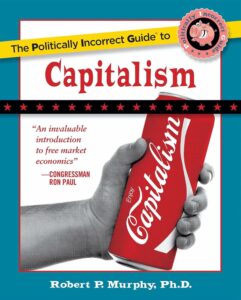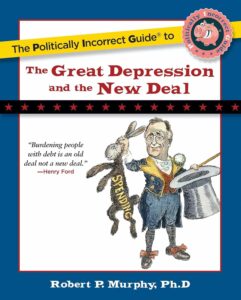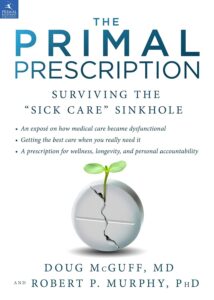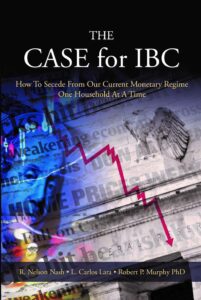I’m No David R. Henderson
I was reading a blog post by David R. Henderson (btw I use his middle initial to distinguish him from a British, free-market economist named David Henderson) where he said this:
About 40 to 60 percent of the economists around my campus–the Naval Postgraduate School–get together for a brown-bag lunch around a table once a month and just talk about whatever is on our minds….
I had an idea. I told everyone that, from the tenor of the discussion, it seemed clear to me that virtually everyone in the room (there were about 9 of us) cared about poor people in poor countries. I asked them to imagine that they had the order of magnitude of wealth that Bill Gates has–at least $10 billion. How, I asked, would they use some part of that wealth to help those people? They could specify the amounts, the organizations, and the causes. I asked them not to talk to each other and to take a few minutes to write things down.
At that point in the story I was flabbergasted. When I was a college professor I had a hard time asking students to take out a sheet of paper for an experiment (involving the Prisoner’s Dilemma), because in the back of my mind it occurred to me they could call my bluff and say, “No, we’re not going to take out a piece of paper. You’re not my dad.”
In a related vein, I never want the remote if a group of people are watching TV. Way too much pressure.
On the other hand, I have no problem telling Bernanke how he should conduct monetary policy. Ishn’t zhat weird?
Murphy Twin Spin
Still on the road; I should be back and blogging next week. In the meantime, I had two Mises Daily Articles this week.
On Monday I discussed the three “exit options” people normally say will rescue us from massive price inflation. The best part of the article is the graphic, which makes it appear that Bernanke is flicking us the bird.
Today I explain that “Everybody Knows Bernanke Is a Joke.” Again, the picture is the best feature of the piece.
But, I know some of you go to Mises.org to read the articles. Sure you do.
The Fed Is Driving Me Crazy
And not how you think. I mean because I have to read articles that defend Bernanke like this (HT2 LRC):
Bernanke in Testimony Can Prove to Ron Paul How QE2 Works in Free Markets
The next time Federal Reserve Chairman Ben S. Bernanke appears before Congress, here are a few visual aids he can use to show critics that quantitative easing is working:
The Standard & Poor’s 500 Index of stocks has climbed 18 percent since he said Aug. 27 that additional asset purchases might be warranted.
The risk premium on high-yield, high-risk bonds has narrowed to 5.16 percentage points from 6.81 percentage points, Bank of America Merrill Lynch index data show.
Inflation expectations have jumped by 44.4 percent…
So much for 2008 Republican vice-presidential candidate Sarah Palin’s assertion that the “dangerous experiment” wouldn’t “magically fix economic problems.”
Quantitative easing “was a key factor in taking deflation risk off the table,” said Peter Hooper, chief economist at Deutsche Bank Securities Inc. in New York. “It certainly helped bolster longer-term inflation expectations…”
The Fed’s Nov. 3 decision to buy $600 billion of Treasury securities through June…sparked the harshest political backlash against the central bank in three decades, with Republican lawmakers warning the additional stimulus risked causing a surge in prices. So far, they were wrong.
Tyler Cowen Embraces ABCT Even More Closely
I have already blogged about the weird weird psychological event in which Tyler Cowen used Austrian business cycle theory to accidentally predict the financial crisis way back in 2005.
In August 2008, when his colleague Bryan Caplan was congratulating central bankers for their expert guidance of the world economy (can’t find the link, let me know if you guys can find it), Tyler wrote this in the NYT:
Behind every financial crisis there is usually a crisis in the real economy, based in some underlying structural deficiency. Even if the financial crisis is bottoming out, sooner or later the real crisis must be faced.
The fundamental problem in the American economy is that, for years, people treated rising asset prices as a substitute for personal savings….
The third problem is that lower consumer spending will require the American economy to make some shifts. That may mean fewer Starbucks and fewer new homes but more tractor production for export to foreign markets. In the long run, shifting some consumption to investment is probably beneficial to the economy; in the short run it means job losses and costly readjustments.
As Mike Myers said in a Wayne’s World movie looking at his contract, “Yes, yes, I like what you’ve done here.”
OK so Tyler explicitly used ABCT to predict the financial crisis, then as it was intensifying he was ahead of the curve by using passages that pre-emptively plagiarized Murphy columns on what was needed for recovery, and now he (and a co-author) write this (HT2 David R. Henderson):
The story runs as follows. Before the financial crash, there were lots of not-so-useful workers holding not-so-useful jobs. Employers didn’t so much bother to figure out who they were. Demand was high and revenue was booming, so rooting out the less productive workers would have involved a lot of time and trouble — plus it would have involved some morale costs with the more productive workers, who don’t like being measured and spied on. So firms simply let the problem lie.
Then came the 2008 recession, and it was no longer possible to keep so many people on payroll. A lot of businesses were then forced to face the music: Bosses had to make tough calls about who could be let go and who was worth saving….
So how should we interpret the recent trickle of good news? Well, one positive note is that less-productive, laid-off workers are undertaking the needed adjustments. For instance, according to a survey by the Pew Research Center, nearly 70 percent of unemployed workers have already made dramatic changes in their career or job-field choice, or are considering doing so. There also have been migrations out of expensive urban areas and into smaller and less expensive ones, such as Austin, Salt Lake City, and northern Virginia, with relatively high-performing industries and more fluid labor markets.
In other words, the U.S. economy is going through some major structural shifts.
So workers were doing stuff doing the boom period for which they were overpaid and actually wasn’t productive, and now they have to be reallocated to different sectors where they will be making less. I think you guys are familiar with this story, since it’s what I’ve been saying for three years.
The only main difference I can see between Tyler’s explanation and mine, is that I see interest rates serve a very important coordinating function in a market economy, and that if the Fed massively distorts them, we shouldn’t be surprised at massive real distortions in the capital and labor markets.
Tyler rejects this theory, saying businessmen are too smart to be fooled by 1% (under Greenspan) fed funds rates. In contrast, Tyler thinks these smart businessmen don’t mind having zero-marginal product workers on their payroll when they are making a ton of money.
Search your feelings, Tyler. You are descended from the Austrian School. Mises is your father. Bernanke knows you have the power to destroy him. Join me, and together we will rule the blogosphere!
Get Yer Red-Hot Zombie Memorabilia
You read a book on Nullification and all you got was this lousy t-shirt…or mug…or mousepad.
Fulfilling Prophecy in Mysterious Ways
I think I have already remarked that I think it’s pretty neat how scoffers didn’t think Jesus could be the Messiah, since He came from Nazareth while the prophesies said He’d come from Bethlehem. (The solution of course is that Jesus was born in Bethlehem, but grew up in Nazareth.)
But today in church we went over a passage that reminded me of something that has puzzled me. Here is Luke 3: 23-31:
23 Now Jesus himself was about thirty years old when he began his ministry. He was the son, so it was thought, of Joseph,
the son of Heli, 24 the son of Matthat,
the son of Levi, the son of Melki,
the son of Jannai, the son of Joseph,
25 the son of Mattathias, the son of Amos,
the son of Nahum, the son of Esli,
the son of Naggai, 26 the son of Maath,
the son of Mattathias, the son of Semein,
the son of Josek, the son of Joda,
27 the son of Joanan, the son of Rhesa,
the son of Zerubbabel, the son of Shealtiel,
the son of Neri, 28 the son of Melki,
the son of Addi, the son of Cosam,
the son of Elmadam, the son of Er,
29 the son of Joshua, the son of Eliezer,
the son of Jorim, the son of Matthat,
the son of Levi, 30 the son of Simeon,
the son of Judah, the son of Joseph,
the son of Jonam, the son of Eliakim,
31 the son of Melea, the son of Menna,
the son of Mattatha, the son of Nathan,
the son of David…
So Joseph (Mary’s husband) was a direct descendant of King David, which satisfies the prophesies saying that a descendant of David will rule on the throne forever.
But hold on a second. As the part I’ve put in bold indicates, Jesus wasn’t actually genetically related to Joseph at all. He was directly conceived in Mary by the Holy Spirit.
Discuss. (And don’t bring up Bryan Caplan.)
Excel Bask
OK computer nerds, I have a stumper for you. I have a huge data set that I need to consolidate. It is like this:
1/2010==Bill Smith==Alpha==Red
1/2010==Bill Smith==Beta==Blue
1/2010==Joe Blow==Alpha==Red
1/2010==Mary Stuart==Gamma==Red
2/2010==Bill Smith==Beta==Blue
2/2010==Mary Stuart==Alpha==Red
2/2010==Mary Stuart==Beta==Blue
2/2010==Mary Stuart==Gamma==Red
2/2010==Mary Stuart==Gamma==Blue
2/2010==Mary Stuart==Gamma==Green
…
So the deal is, on any particular date, any of the population may have one or more entries, which are coded Apha, Beta, or Gamma, and also have colors associated with them.
But for my purposes, all I care about is on any given data, if a particular person has (a) an Alpha or a Beta, and (b) a Gamma. I don’t care about the colors. So I want to consolidate the above list into something like this:
1/2010==Bill Smith==Alpha/Beta
1/2010==Joe Blow==Alpha/Beta
1/2010==Mary Stuart==Gamma
2/2010==Bill Smith==Alpha/Beta
2/2010==Mary Stuart==Alpha/Beta
2/2010==Mary Stuart==Gamma
…
Any thoughts? Unfortunately I can’t do any neat tricks with a Pivot Table, because the list is so big that it doesn’t fit on one sheet. (And I don’t think you can do a Pivot Table on more than one sheet of data?) So my plan is to take the original list in small chunks onto a new sheet, and then apply the consolidation to each chunk, and then combine all the output into one final list that will fit on a single worksheet to which I can then do the Pivot Table jiu jitsu.
Any ideas? I’m assuming I need to write a macro for it, but as in economics, I am not good at macro.
It’s Good to Have a Printing Press
I came across these figures for a Mises.org article. I hadn’t seen them reported:
The Federal Reserve Board on Monday announced preliminary unaudited results indicating that the Reserve Banks provided for payments of approximately $78.4 billion of their estimated 2010 net income of $80.9 billion to the U.S. Treasury. This represents a $31.0 billion increase in payments to the U.S. Treasury over 2009 ($47.4 billion of $53.4 billion of net income). The increase was due primarily to increased interest income earned on securities holdings during 2010.
There are other interesting stats at the link.







Recent Comments